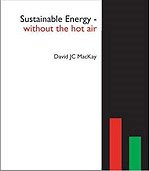 Cambridge physicist David MacKay is receiving heaps of praise for his new book, "Sustainable Energy-without the hot air." Described by boingboing as "the Freakonomics of conservation, climate, and energy," The Guardian has declared the book "this year's must-read." And when I saw this blurb among the endorsements from academics,
Cambridge physicist David MacKay is receiving heaps of praise for his new book, "Sustainable Energy-without the hot air." Described by boingboing as "the Freakonomics of conservation, climate, and energy," The Guardian has declared the book "this year's must-read." And when I saw this blurb among the endorsements from academics,I took it to the loo and almost didn't come out again.I knew I had to take a look. (Naturally, I jumped ahead to the chapter on nuclear energy.)
- Matthew Moss, Private Secretary to the Vice-Chancellor, University of Cambridge
With clarity and objectivity, MacKay walks the reader through detailed explanations of nuclear fission, uranium, thorium, land use, and safety. And in a section called Mythconceptions, he dispels several of the popular arguments against nuclear power.
Sustainable Energy can be downloaded for free at MacKay's site here, though the quality of this remarkable book really deserves remuneration. And besides, who would want to read "the unlikeliest beach book of the year" on theirBuilding a nuclear power station requires huge amounts of concrete and steel, materials whose creation involves huge CO2 pollution.
The steel and concrete in a 1 GW nuclear power station have a carbon footprint of roughly 300 000 t CO2.
Spreading this “huge” number over a 25-year reactor life we can express this contribution to the carbon intensity in the standard units (g CO2per kWh(e)),
carbon intensity
associated with construction= _______300× 109 g_______ 106 kW(e) × 220 000 h = 1.4 g/kWh(e), which is much smaller than the fossil-fuel benchmark of 400 g CO2/kWh(e). The IPCC estimates that the total carbon intensity of nuclear power (including construction, fuel processing, and decommissioning) is less than 40 g CO2/kWh(e) (Sims et al. 2007).
Please don’t get me wrong: I’m not trying to be pro-nuclear. I’m just pro-arithmetic.
0 comments:
Post a Comment